
Original publish date: June 15, 2018
Confederate General James Longstreet’s reputation was thrown under the bus by the widow of his former friend, General George Pickett. It was Longstreet who ordered Pickett forward at Gettysburg, in what has become known as “Pickett’s Charge.” The incident is widely acknowledged by historians as General Robert E. Lee’s biggest tactical mistake of the Civil War. Pickett’s widow, LaSalle, considered it her mission to resurrect the damaged career of her slighted husband. Sadly, she did it at the expense of James Longstreet.

LaSalle (aka “Sallie”) spent the decades following her husband’s 1875 death (by scarlet fever) writing, speaking and creating an idealized version of “her soldier” as the ideal Southern gentleman. Her campaign to sainthood for General Pickett began when she published the book “Pickett and His Men”, a history of her husband’s military campaigns in 1899. She also published 2 other books, The Heart of a Soldier, As Revealed in the Intimate Letters of Gen’l George E. Pickett (1913) and Soldier of the South: General Pickett’s War Letters to His Wife (1928). All 3 works projected Pickett as a figure cloaked in “Lost Cause” mythology.
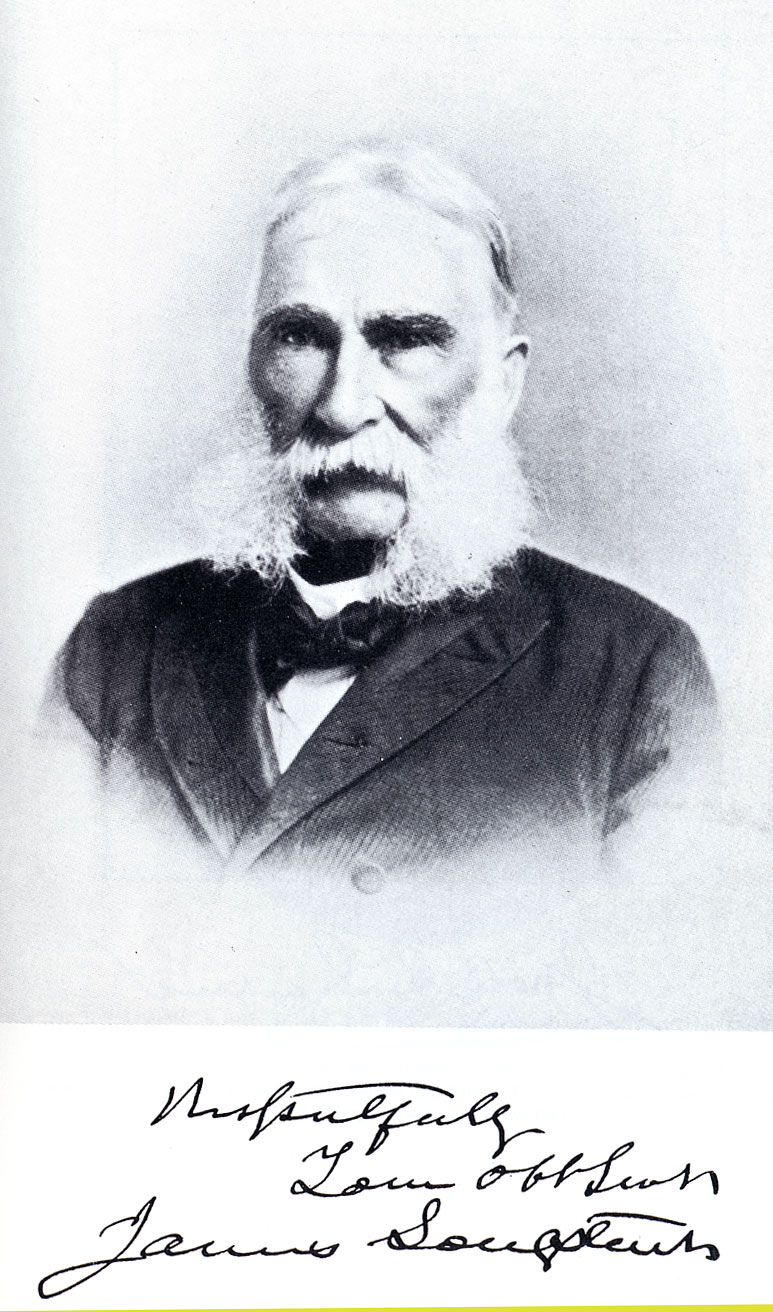 Her efforts worked and today, Pickett is widely remembered as a tragic hero of the disastrous charge at Gettysburg that bears his name. Rather than place blame at the feet of the South’s “Marble Man”, Robert E. Lee, LaSalle shifted blame to James Longstreet. Her effort was well received by the purveyors of the Lost Cause and Pickett’s reputation was posthumously restored.
Her efforts worked and today, Pickett is widely remembered as a tragic hero of the disastrous charge at Gettysburg that bears his name. Rather than place blame at the feet of the South’s “Marble Man”, Robert E. Lee, LaSalle shifted blame to James Longstreet. Her effort was well received by the purveyors of the Lost Cause and Pickett’s reputation was posthumously restored.
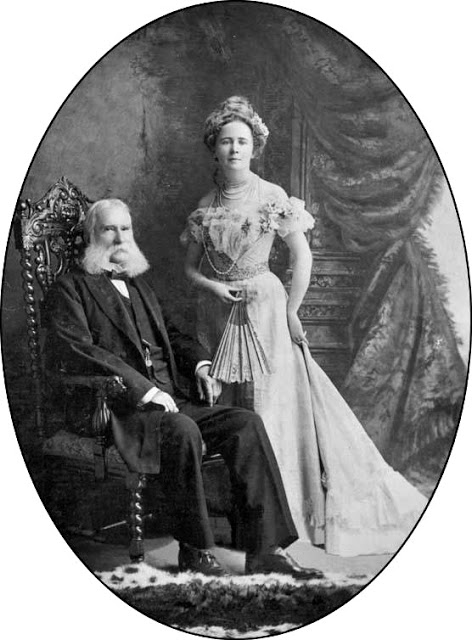 But General Longstreet had a secret weapon of his own: his young bride, Helen Dortch Longstreet. The General married her in 1897 in a ceremony at the governor’s mansion in Atlanta. She was 34 and he was 76. She would outlive her husband by 58 years, passing away in 1962 during the National Centennial Celebration of the Civil War. By the time of her death, she had accomplished more than most any other woman of her era and helped restore her husband’s legacy along the way. And I have the letters to prove it.
But General Longstreet had a secret weapon of his own: his young bride, Helen Dortch Longstreet. The General married her in 1897 in a ceremony at the governor’s mansion in Atlanta. She was 34 and he was 76. She would outlive her husband by 58 years, passing away in 1962 during the National Centennial Celebration of the Civil War. By the time of her death, she had accomplished more than most any other woman of her era and helped restore her husband’s legacy along the way. And I have the letters to prove it.
As detailed in part I of this series, Confederate General James Longstreet was an important figure in American military history. He was pivotal in every battle he participated in (which includes most of the important battles of the Civil War) and was one of the first to question the wisdom of strategies and leaders that shaped the course of the Great Rebellion. He was present when hostilities ceased at Appomattox and was one of the first of the Rebel leaders to reintegrate into the Union. While disappointed by the outcome, he was quick to recognize the results of the struggle. For his reluctance to embrace the “Lost Cause” and refusal to “wave the bloody shirt”, Longstreet paid a high price.
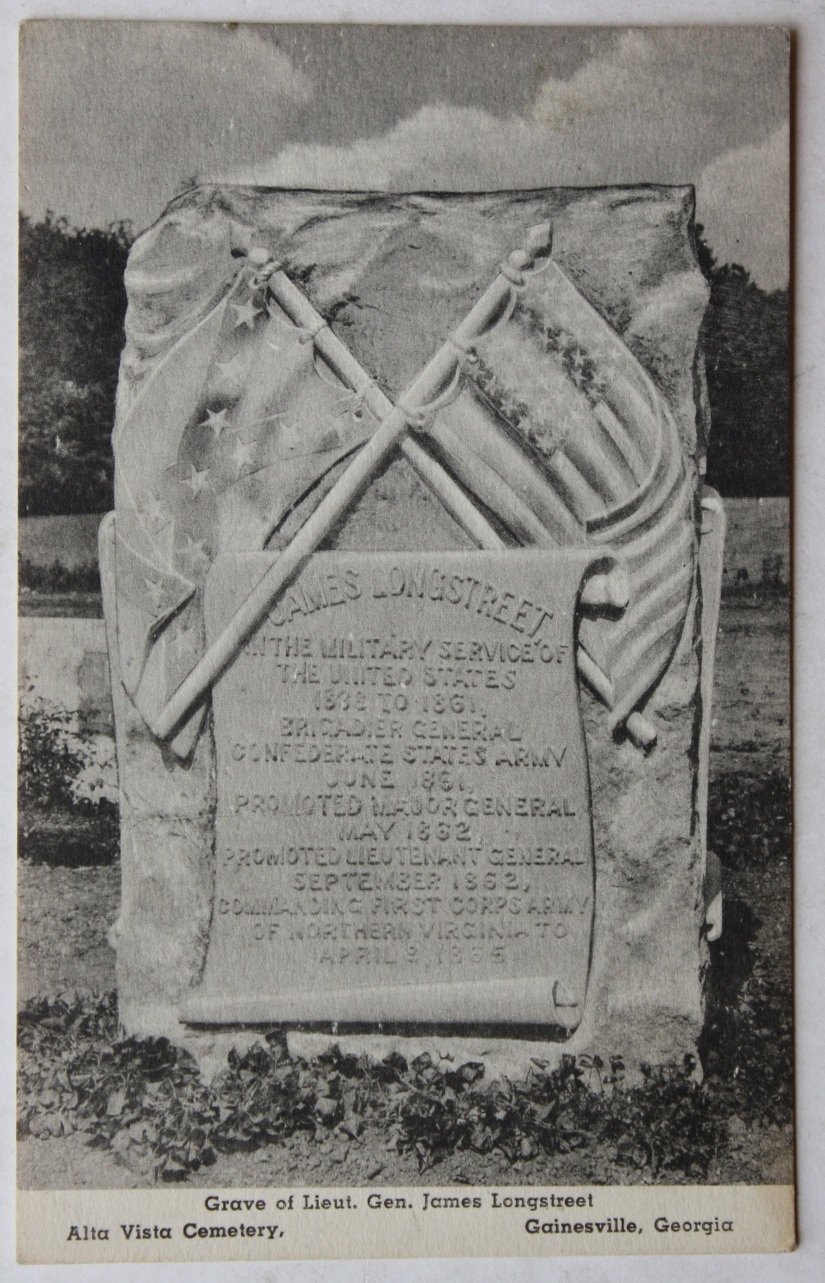 Longstreet served in a variety of government positions after the war, including ambassador to Turkey and as a Federal Marshall. He served as a railroad commissioner and spent his final years trying to refute continued attacks on his character raised by his former friends and brothers in arms who labeled him as a traitor to a failed ideal. His 1896 memoirs, a labor of five years titled “From Manassas to Appomattox”, he attempted to set the record straight.
Longstreet served in a variety of government positions after the war, including ambassador to Turkey and as a Federal Marshall. He served as a railroad commissioner and spent his final years trying to refute continued attacks on his character raised by his former friends and brothers in arms who labeled him as a traitor to a failed ideal. His 1896 memoirs, a labor of five years titled “From Manassas to Appomattox”, he attempted to set the record straight.

Longstreet’s final years were marked by poor health and partial deafness. By 1902 he suffered from severe rheumatism and was unable to stand for more than a few minutes at a time. By January 1903, his weight dropped from 200 to 135 pounds, cancer developed in his right eye, and he underwent X-ray therapy in Chicago to treat it. He contracted pneumonia and died in Gainesville, Georgia on January 2, 1904, six days before his 83rd birthday. Longstreet outlived most of his contemporary detractors, and was one of only a handful of Civil War Generals to live into the 20th century.
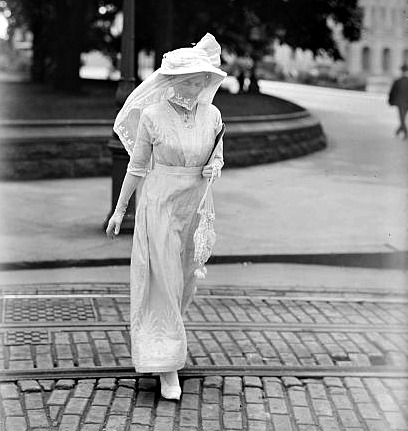
For the next 58 years, Helen Longstreet worked tirelessly to rebuild the General’s tattered legacy. She wrote “Lee and Longstreet at High Tide” in which she stated that “the South was seditiously taught to believe that the Federal Victory was wholly the fortuitous outcome of the culpable disobedience of General Longstreet.” Regardless, white ex-Confederates could never forgive his postwar racial and political treason, so they trashed his wartime military record. Helen determined that her husband would not become a scapegoat for the Lost Cause. Widow Longstreet’s idea for the big “get even” was that the best revenge was success. Both the success of the General and that of her own.
Helen Dortch Longstreet earned the nickname of the “Fighting Lady” for being a champion of many causes including environmental preservation, physical fitness, women’s rights, civil rights and as a Confederate memorialist. She was the first woman to run for public office in the state of Georgia and was thereby instrumental in breaking down the prejudice against women holding high political positions. She was the driving force behind the creation of a state park at Tallulah Gorge. She opposed a plan by Georgia Power to build a series of hydroelectric dams along the Tallulah River. Although unsuccessful, her campaign was the first conservation movements in America championed by a woman.
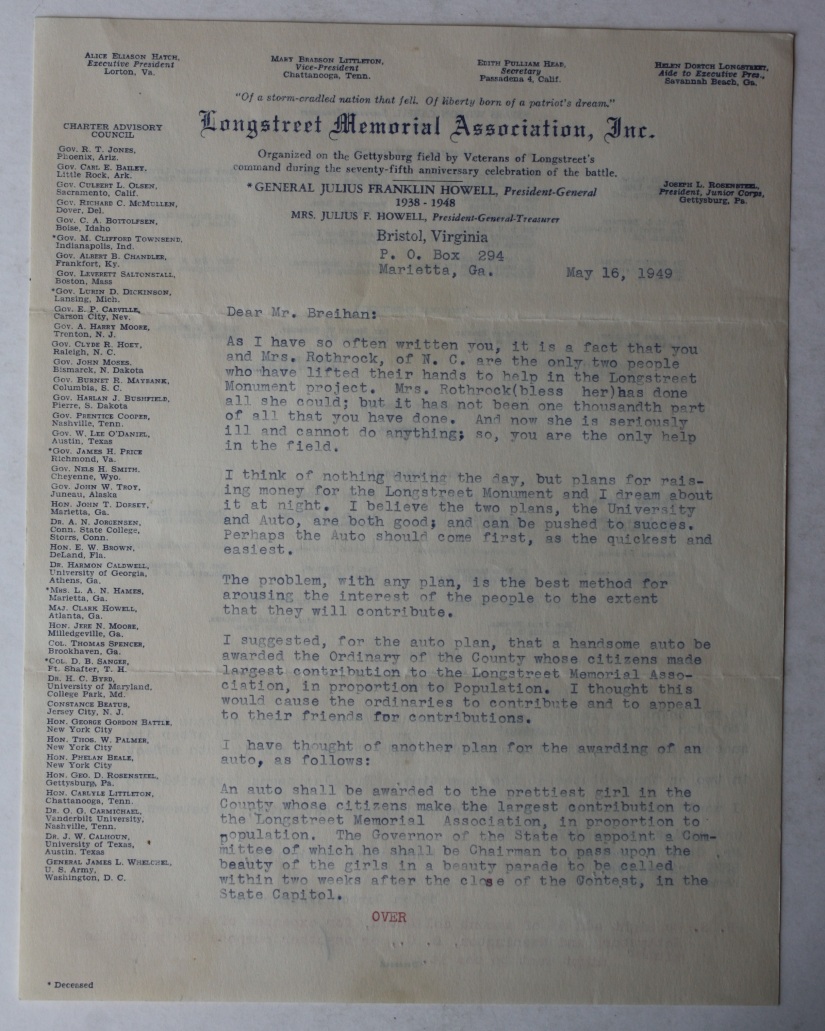
Originally, my personal interest in the widow Longstreet was directly tied to her husband’s exploits at Gettysburg. That all changed several years ago when I came across a trio of letters written by Mrs. Longstreet. I was astonished to find these letters were dated 1949-51, nearly half a century after General James Longstreet died and 90 years after the Civil War began. How could this be? I began to research Helen Dortch Longstreet and discovered what an amazing woman she was. These letters were written just before and shortly after Mrs. Longstreet ran an unsuccessful write-in campaign for governor of the State of Georgia against Herman Talmadge in 1950. Her main complaint? Blacks were not allowed to vote in the primary.
The first letter, dated May 16, 1949, is on the ornate letterhead of the “Longstreet Memorial Association” that was “Organized on the Gettysburg field by Veterans of Longstreet’s command during the seventy-fifth anniversary celebration of the battle” in 1938. Association member names are listed at the side and include 20 Governors (there were only 48 states at the time and Indiana’s Clifford Townsend is among them), College / University Presidents, Congressmen, Senators and military officers. The letter was written to Col. Carl W. Breihan of Lemay, Missouri. Breihan, a former St. Louis County Police Commissioner, was recognized as an authority on outlaws Frank and Jesse James and the Younger brothers and author of 12 books on Wild West anti-heroes including Jesse James, Billy the Kid and Quantrill’s Raiders.
Widow Longstreet writes, “I think of nothing during the day, but plans for raising money for the Longstreet Monument and I dream about it at night.” Mrs. Longstreet details her plan to raise funds for the monument by awarding a new 1949 Kaiser-Frazer automobile to the “prettiest girl in the County whose citizens make the largest contribution to the Longstreet Memorial Association in proportion to population.” Mrs. Longstreet states, “I thought this would cause the ordinaries to contribute and to appeal to their friends for contributions…I would risk my life on the bet that this plan will prove a glorious success.” Mrs. Longstreet’s ambitious plan included buying 48 Kaiser-Frazer cars (at $ 2,000 each) on credit to be awarded in all 48 states.
 The letter continues, “The auto dealers will pay more attention to the plan if presented by a young, vigorous, intelligent gentleman like yourself, than by an old woman….I could never make them understand that behind the wrinkles and gray hairs the vigor and enthusiasm of youth still lives…When the monument stands finished on the field of glory, Carl W. Breihan, more than any other person in the world will deserve the credit.” She added the postscript, “I went on a little speaking trip to Cleveland, Ohio and received such an ovation, I may run for President.”
The letter continues, “The auto dealers will pay more attention to the plan if presented by a young, vigorous, intelligent gentleman like yourself, than by an old woman….I could never make them understand that behind the wrinkles and gray hairs the vigor and enthusiasm of youth still lives…When the monument stands finished on the field of glory, Carl W. Breihan, more than any other person in the world will deserve the credit.” She added the postscript, “I went on a little speaking trip to Cleveland, Ohio and received such an ovation, I may run for President.”
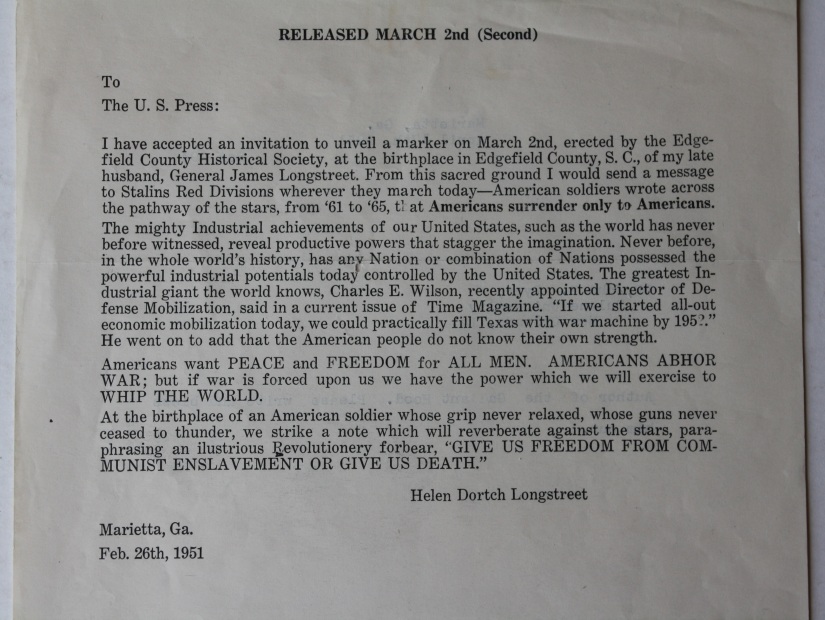 The next letter is in the form of a press release. Dated Feb. 26, 1951, it mentions the unveiling of a marker at General Longstreet’s South Carolina birthplace that likely includes excerpts from her planned speech at the ceremony. “I would send a message to Stalin’s Red Divisions wherever they march today-American soldiers wrote across the pathway of the stars, from ’61 to ’65, that Americans surrender only to Americans….Americans want PEACE and FREEDOM for ALL MEN. AMERICANS ABHOR WAR; but if war is forced upon us we have the power which will exercise to WHIP THE WORLD…At the birthplace of an American soldier whose grip never relaxed, whose guns never ceased to thunder, we strike a note which will reverberate against the stars.”
The next letter is in the form of a press release. Dated Feb. 26, 1951, it mentions the unveiling of a marker at General Longstreet’s South Carolina birthplace that likely includes excerpts from her planned speech at the ceremony. “I would send a message to Stalin’s Red Divisions wherever they march today-American soldiers wrote across the pathway of the stars, from ’61 to ’65, that Americans surrender only to Americans….Americans want PEACE and FREEDOM for ALL MEN. AMERICANS ABHOR WAR; but if war is forced upon us we have the power which will exercise to WHIP THE WORLD…At the birthplace of an American soldier whose grip never relaxed, whose guns never ceased to thunder, we strike a note which will reverberate against the stars.”

The third and final letter was written on New Years Eve of 1951. It is a typed letter on the ornate letterhead of the “Physical Culture Hotel” in Dansville, New York. Again written to Mr. Briehan, it reads in part, “My great loneliness and longing for ‘the touch of a vanished hand and the sound of a voice that is stilled,’ seem greater than I can bear at Christmas.” The letter mentions the Longstreet Monument briefly but is mostly devoted to finding Briehan an editor for his first book (The Complete and Authentic Life of Jesse James 1953). In my opinion, the letterhead speaks more about the widow than does the text.

 The Physical Culture Hotel, founded by former professional wrestler and magazine mogul Bernarr MacFadden, began life as the “Jackson Sanitorium” (founded in 1854), a health spa credited with inventing granola and launching the Kellogg cereal company. The Hotel was a pioneer in the use of hydrotherapy but also emphasized recreation and social activities such as swimming, sunbathing, tennis, and dancing. McFadden and his hotel were on the cutting edge of the physical fitness movement in America and at age 88, Helen Dortch Longstreet was right in the center of it. To me, this letter is emblematic of the widow Longstreet. She was ahead of her time, unpredictable and most of all, she never gave up.
The Physical Culture Hotel, founded by former professional wrestler and magazine mogul Bernarr MacFadden, began life as the “Jackson Sanitorium” (founded in 1854), a health spa credited with inventing granola and launching the Kellogg cereal company. The Hotel was a pioneer in the use of hydrotherapy but also emphasized recreation and social activities such as swimming, sunbathing, tennis, and dancing. McFadden and his hotel were on the cutting edge of the physical fitness movement in America and at age 88, Helen Dortch Longstreet was right in the center of it. To me, this letter is emblematic of the widow Longstreet. She was ahead of her time, unpredictable and most of all, she never gave up.
 Further research reveals that, during World War II, Mrs. Longstreet was a Rosie the Riveter assembling B-29 bombers at the Bell Aircraft plant in Atlanta. She explained, “I was at the head of my class in riveting school. In fact I was the only one in it.” She worked in the factory for two years, refused to join the union, never missed a day of work or showed up late for a shift. Widow Longstreet told Life magazine reporters, surprised to find a Civil War General’s widow alive and well and working for the war effort, “I just want to build bombers to bomb Hitler.”
Further research reveals that, during World War II, Mrs. Longstreet was a Rosie the Riveter assembling B-29 bombers at the Bell Aircraft plant in Atlanta. She explained, “I was at the head of my class in riveting school. In fact I was the only one in it.” She worked in the factory for two years, refused to join the union, never missed a day of work or showed up late for a shift. Widow Longstreet told Life magazine reporters, surprised to find a Civil War General’s widow alive and well and working for the war effort, “I just want to build bombers to bomb Hitler.”
Mrs. Longstreet had been a Progressive Party member who had supported Theodore Roosevelt for President as a delegate to the Progressive Party convention in 1912. With her spirit of progressive political activism reinvigorated, Longstreet spent the next 50 years trying to resuscitate her husband’s wartime reputation. Not only did she organize the Longstreet Memorial Association, she created both the Longstreet Memorial Exhibit at the New York World’s Fair in 1939 and at the Golden Gate Exposition in San Francisco in 1940. In 1947, she became the first woman to have her portrait placed in the Georgia State Capitol. By 1956, Helen Longstreet was suffering from deteriorating mental health. She was placed in the Central State Mental Hospital in Milledgeville, Georgia in 1957, where she remained until her death on May 3, 1962. She is buried in West View Cemetery in Atlanta.

And what became of her husband’s chief detractor, LaSalle Corbell Pickett, wife of General George Pickett? She died on March 22, 1931, having outlived her husband by more than 55 years. But she would not rest in peace. Richmond, Virginia’s Hollywood Cemetery declined to allow her to be buried next to her husband. That was until Pickett’s grandson, Lieutenant George E. Pickett III, threatened to have his grandfather disinterred and moved to Arlington National Cemetery where they could rest side-by-side. Hollywood Cemetery quickly agreed to permit LaSalle’s interment there, but for reasons unknown, the request went unfulfilled.
LaSalle’s remains were cremated and interred at Abbey Mausoleum in Arlington, Virginia. Originally a mausoleum for the wealthiest citizens of Washington, DC, it went bankrupt in 1968. The structure fell into disrepair and was vandalized many times and several graves desecrated. In 1976, vandals opened and desecrated 12 coffins and 10 urns. One crypt was completely opened and the coffin left opened. Vandals placed a copy of heavy metal magazine “Circus” on the chest of the skeleton. Additionally, ashes were poured on the floor and smiley faces drawn in them.
In 1979, 45 crypts were broken into, coffins removed, and the corpses decapitated. The skulls were left perched atop broomsticks and left upright around the tomb. In the late 1980s, vandals opened urns and poured the contents onto the floor, mixing remains together and again writing in the ashes. In 1994, police discovered bloody hand prints, candles, dead cats, pentagrams, and other signs of occult worship. Two crypts were opened, the coffins placed on the floor, and the remains exposed.
 In 1998, the Military Order of the Stars and Bars and United Daughters of the Confederacy worked together to pay for LaSalle’s disinterment and reburial in front of the George E. Pickett Memorial in Hollywood Cemetery. Widow Pickett was buried on Saturday, March 21, 1998. She was the first woman interred in the Confederate military burial section. On July 3 of that same year, one of the last monuments was erected on the Gettysburg National Military Park. It was an equestrian statue of General James Longstreet on his horse “Hero” in Pitzer Woods on Confederate Avenue. Perhaps most astonishingly, 135 years after the battle, Jamie Longstreet Paterson, the 67-year-old granddaughter of General Longstreet was there to see it.
In 1998, the Military Order of the Stars and Bars and United Daughters of the Confederacy worked together to pay for LaSalle’s disinterment and reburial in front of the George E. Pickett Memorial in Hollywood Cemetery. Widow Pickett was buried on Saturday, March 21, 1998. She was the first woman interred in the Confederate military burial section. On July 3 of that same year, one of the last monuments was erected on the Gettysburg National Military Park. It was an equestrian statue of General James Longstreet on his horse “Hero” in Pitzer Woods on Confederate Avenue. Perhaps most astonishingly, 135 years after the battle, Jamie Longstreet Paterson, the 67-year-old granddaughter of General Longstreet was there to see it.
Next week-Part III

